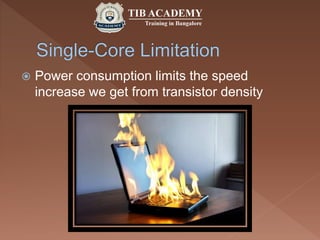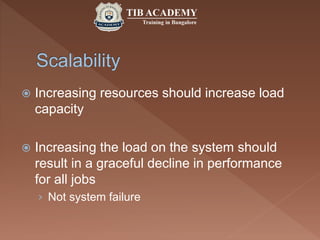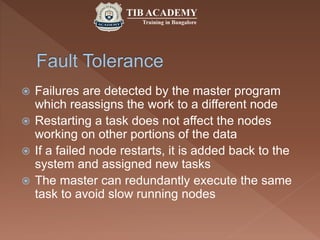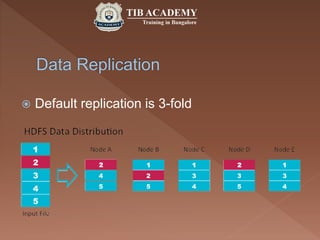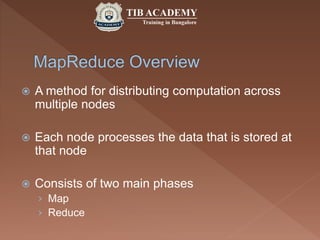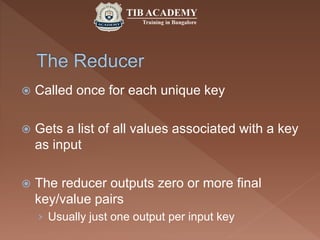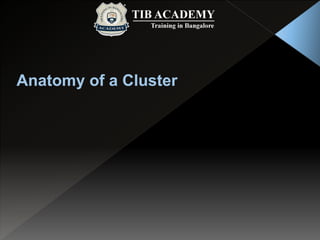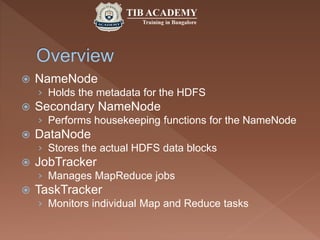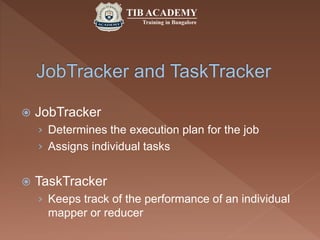Hadoop tutorial for beginners-tibacademy.in
- 1. TIB Academy, 5/3, Varathur Road, Kundalahalli Gate, Bangalore-560066. +91-9513332301 / 02 www.tibacademy.in
- 2. Open source software framework designed for storage and processing of large scale data on clusters of commodity hardware Created by Doug Cutting and Mike Carafella in 2005. Cutting named the program after his son’s toy elephant.
- 3. Data-intensive text processing Assembly of large genomes Graph mining Machine learning and data mining Large scale social network analysis
- 5. • Contains Libraries and other modules Hadoop Common • Hadoop Distributed File SystemHDFS • Yet Another Resource Negotiator Hadoop YARN • A programming model for large scale data processing Hadoop MapReduce
- 7. What were the limitations of earlier large- scale computing? What requirements should an alternative approach have? How does Hadoop address those requirements?
- 8. Historically computation was processor- bound › Data volume has been relatively small › Complicated computations are performed on that data Advances in computer technology has historically centered around improving the power of a single machine
- 10. Moore’s Law › The number of transistors on a dense integrated circuit doubles every two years Single-core computing can’t scale with current computing needs
- 11. Power consumption limits the speed increase we get from transistor density
- 12. Allows developers to use multiple machines for a single task
- 13. Programming on a distributed system is much more complex › Synchronizing data exchanges › Managing a finite bandwidth › Controlling computation timing is complicated
- 14. “You know you have a distributed system when the crash of a computer you’ve never heard of stops you from getting any work done.” –Leslie Lamport Distributed systems must be designed with the expectation of failure
- 15. Typically divided into Data Nodes and Compute Nodes At compute time, data is copied to the Compute Nodes Fine for relatively small amounts of data Modern systems deal with far more data than was gathering in the past
- 16. Facebook › 500 TB per day Yahoo › Over 170 PB eBay › Over 6 PB Getting the data to the processors becomes the bottleneck
- 17. Must support partial failure Must be scalable
- 18. Failure of a single component must not cause the failure of the entire system only a degradation of the application performance Failure should not result in the loss of any data
- 19. If a component fails, it should be able to recover without restarting the entire system Component failure or recovery during a job must not affect the final output
- 20. Increasing resources should increase load capacity Increasing the load on the system should result in a graceful decline in performance for all jobs › Not system failure
- 21. Based on work done by Google in the early 2000s › “The Google File System” in 2003 › “MapReduce: Simplified Data Processing on Large Clusters” in 2004 The core idea was to distribute the data as it is initially stored › Each node can then perform computation on the data it stores without moving the data for the initial processing
- 22. Applications are written in a high-level programming language › No network programming or temporal dependency Nodes should communicate as little as possible › A “shared nothing” architecture Data is spread among the machines in advance › Perform computation where the data is already stored as often as possible
- 23. When data is loaded onto the system it is divided into blocks › Typically 64MB or 128MB Tasks are divided into two phases › Map tasks which are done on small portions of data where the data is stored › Reduce tasks which combine data to produce the final output A master program allocates work to individual nodes
- 24. Failures are detected by the master program which reassigns the work to a different node Restarting a task does not affect the nodes working on other portions of the data If a failed node restarts, it is added back to the system and assigned new tasks The master can redundantly execute the same task to avoid slow running nodes
- 26. Responsible for storing data on the cluster Data files are split into blocks and distributed across the nodes in the cluster Each block is replicated multiple times
- 27. HDFS is a file system written in Java based on the Google’s GFS Provides redundant storage for massive amounts of data
- 28. HDFS works best with a smaller number of large files › Millions as opposed to billions of files › Typically 100MB or more per file Files in HDFS are write once Optimized for streaming reads of large files and not random reads
- 29. Files are split into blocks Blocks are split across many machines at load time › Different blocks from the same file will be stored on different machines Blocks are replicated across multiple machines The NameNode keeps track of which blocks make up a file and where they are stored
- 30. Default replication is 3-fold
- 31. When a client wants to retrieve data › Communicates with the NameNode to determine which blocks make up a file and on which data nodes those blocks are stored › Then communicated directly with the data nodes to read the data
- 33. A method for distributing computation across multiple nodes Each node processes the data that is stored at that node Consists of two main phases › Map › Reduce
- 34. Automatic parallelization and distribution Fault-Tolerance Provides a clean abstraction for programmers to use
- 35. Reads data as key/value pairs › The key is often discarded Outputs zero or more key/value pairs
- 36. Output from the mapper is sorted by key All values with the same key are guaranteed to go to the same machine
- 37. Called once for each unique key Gets a list of all values associated with a key as input The reducer outputs zero or more final key/value pairs › Usually just one output per input key
- 40. NameNode › Holds the metadata for the HDFS Secondary NameNode › Performs housekeeping functions for the NameNode DataNode › Stores the actual HDFS data blocks JobTracker › Manages MapReduce jobs TaskTracker › Monitors individual Map and Reduce tasks
- 41. Stores the HDFS file system information in a fsimage Updates to the file system (add/remove blocks) do not change the fsimage file › They are instead written to a log file When starting the NameNode loads the fsimage file and then applies the changes in the log file
- 42. NOT a backup for the NameNode Periodically reads the log file and applies the changes to the fsimage file bringing it up to date Allows the NameNode to restart faster when required
- 43. JobTracker › Determines the execution plan for the job › Assigns individual tasks TaskTracker › Keeps track of the performance of an individual mapper or reducer
- 45. MapReduce is very powerful, but can be awkward to master These tools allow programmers who are familiar with other programming styles to take advantage of the power of MapReduce
- 46. Hive › Hadoop processing with SQL Pig › Hadoop processing with scripting Cascading › Pipe and Filter processing model HBase › Database model built on top of Hadoop Flume › Designed for large scale data movement











